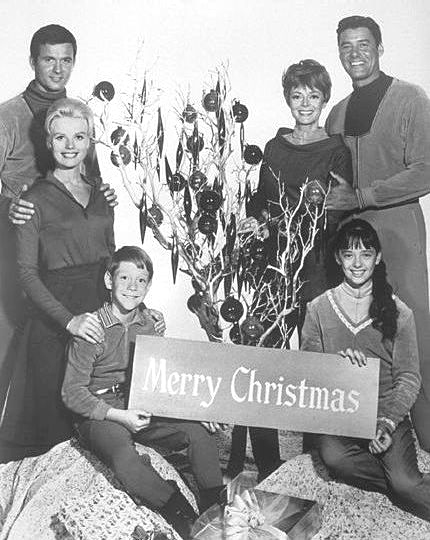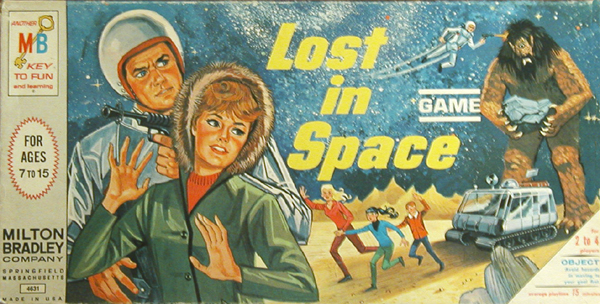|
Page A3 The Joan De Arc Crusader / Saturday, December 24, 2005 Front Page A1 / Editorials A2 / Crossword A4
‘Lost in Joan De Arc Space’By J. Bueker A kid growing up during the “Space Age” enjoyed a number of unique privileges quite unknown to earlier generations of American children: The opportunity to sip Tang for breakfast, snack on Space Food Sticks between meals, build and fly working model rockets, and most significantly to watch actual human beings engaging in actual space flight from the comfort of one’s own living room. The enduring effect of these influences upon the popular culture and thus the Boomer psyche can hardly be overestimated. And so it was forty years ago this fall that one of the more charming and enduring of these Space Age influences manifested itself in the form of a quasi-operatic science fiction television series for kids on CBS called “Lost in Space.” The interminable adventures of the Space Family Robinson quickly became part and parcel of childhood in mid -‘60s America, and were an instant hit on Joan De Arc Avenue.
I vividly recall the evening in September 1965 when the series premiere
aired. My three siblings and I crowded around the black and white Philco in our
family room, watching mesmerized as the story of Dr. Zachary Smith’s foul
betrayal of the Robinson’s brave mission to Alpha That first episode featured a surprise gimmick that the show maintained until the end of the second year: an action-packed cliffhanger ending that would suddenly freeze at the instant of greatest peril as the words “To Be Continued Next Week” materialized on the screen. We would then spend the entire following week worrying about whether Will Robinson was really going to be vaporized by the oncoming meteorite, or how Penny and Dr. Smith might survive the cosmic quicksand that the good doctor had foolishly led them into. We rushed into the master bedroom on 3219 as the show ended to apprise our mother of the heart-stopping conclusion of the first episode of this cool new show. She was immediately reminded of the serials that she had seen in Detroit movie houses on Saturdays back in the ‘40s, which utilized the same end-of-show device to entice the kids back to the theater the following week. Not too difficult to see where her youngest gets his propensity for childhood nostalgia. “Lost in Space” rapidly became one of the most popular playtime activities for kids on Joan De Arc. We had the entire street to use for different planets and for the various interplanetary realms, and the open field to the west of Surrey Heights provided an expansive and convincing extraterrestrial landscape. The picnic table in the backyard at 3219 often served as an excellent “Chariot” for our planetary excursions, whenever traveling across a planet became a necessity. Yet the ultimate place to play “Lost in Space” was without question the backyard of the Wells house. Art Wells, the patriarch of the Wells family, seemed a somewhat cantankerous and aloof man to us kids. He worked for Salt River Project as an electrical lineman, a trade he had originally learned in Kansas before the Wells came west to Arizona in 1964. Art actually knew quite a bit about electronics, and he was a dedicated ham radio operator. The Wells home had a towering radio antenna anchored in the backyard, extending forty feet or more into the air. Entire rooms of the Wells home were devoted to housing Art’s radio equipment, and he spent hours in the evenings chatting with people all over the world. The man was also a prize winning kite flyer, a talent that he demonstrated out on the street one day much to our utter astonishment. That damn kite looked like it was floating about five miles downwind by the time he started reeling her back in. Mr. Wells was also a devoted Cub Scout pack leader for a number of years, and an avid photography bug to boot. In retrospect, Art Wells was actually a very interesting person. And it was Art’s extensive collection of radio equipment that made possible the construction of a most excellent “Jupiter 2” spacecraft on the back patio of the Wells home. Art allowed son Mark to have a number of his older, discarded radio units that we skillfully assembled on the Wells picnic table to create a totally cool and convincing control panel for our space ship. Each of the radio units featured a rich variety of buttons, dials and gauges that we could designate for whatever functions were deemed necessary to control our travels through the galaxy. The nearby radio tower also provided an outstanding prop to use in our play – we typically designated it as a drill for the “deutronium” fuel that the Robinsons habitually sought on the show to provide their spacecraft with the necessary power to make a successful return to Earth; but we also used the tower for various other purposes as our imaginations dictated at the moment. I usually assumed the role of Professor John Robinson to Mark’s Major Don West. Chris Dickey would often take the role of the family robot, expertly squealing “Danger, danger” at just the wrong moment. Chris never took the play quite as seriously as Mark or I, and he delighted in looking for opportunities to say or do something funny. My brother Charles occasionally sat in with his excellent impersonation of Dr. Smith, and other kids on the street at times appeared in various guest roles. However Mark and I would often simply pretend that the other characters were present as we carried on our cosmic adventures.
For some reason I well remember a rainy day in 1968 when Mark and I were
unable to play "Lost in Space" outdoors, and so retreated to the garage at 3219
for a rather surreal Lost in Space play time experience wherein we imagined
ourselves as Professor Robinson and Major West trapped inside a dark and
foreboding space station somewhere in a forgotten corner of the galaxy. We
utilized the ladder in the Bueker garage as a prop in our play, visualizing the
steps as the portal of some kind of trans-dimensional transportation device. Why
this particular episode of play remains so clearly in my memory is uncertain to
me. Perhaps it was the novelty of the circumstances and the setting. We must
have had a particularly fun time that day. Of course, we just had to have the “Lost in Space” board game. The Milton Bradley product actually turned out to be one of the most boring and mindless games the company ever produced. I don’t think we bothered playing it again after our first or second attempt, such was its remarkably tedious inanity. On the other hand, the original “Lost in Space” Aurora model kits were awesomely cool, featuring the Cyclops monster from the first season threatening the Robinsons and their chariot with a huge boulder. These kits are now highly prized collector’s items. The Robinson’s attempts to return to earth were probably matched in their maddening futility only by their amazingly inept contemporaries, the castaways on “Gilligan’s Island.” No small irony lay in the fact that the cast member most vociferously determined to return home, Dr. Smith, usually was the one to ruin the opportunities for getting back, much as Gilligan did to the dismay of his friends on the island. Of course as we were fond of observing at the time, “If they get rescued, the show ends.” Billy Mumy (Will Robinson) made a valiant attempt in the ‘80s to get a reunion episode with the original cast produced, in which the fate of the marooned family Robinson would finally be resolved once and for all. Unfortunately, series creator Irwin Allen wasn’t interested. Twit. In the final analysis, "Lost in Space" was about a close-knit family sticking together in the face of unimaginable adversity. Even if the show did decline from a first rate space adventure to a regrettable exercise in pop-camp melodrama in three short years, the theme of family always shone through and in large part accounts for the show's lasting appeal. “Lost in Space” in any case provided the inspiration for many hours of good clean fun for the kids on Joan De Arc Avenue. "Lost in Space" originally aired from September 1965 to April 1968. The series had a very successful run in syndication and is now widely available on DVD. Only a “bubble-headed booby” could resist a smile viewing this sweet old relic from our TV past. ________________________________________________________________________________________________________________________JDA
Front Page A1 / Editorials A2 / Crossword A4
|
 Centauri unfolded. In these early episodes of the series, Dr. Smith was actually
a convincingly sinister presence on the show, a remarkable contrast to the silly
buffoon that he would become by the largely regrettable third (and final)
season.
Centauri unfolded. In these early episodes of the series, Dr. Smith was actually
a convincingly sinister presence on the show, a remarkable contrast to the silly
buffoon that he would become by the largely regrettable third (and final)
season. 